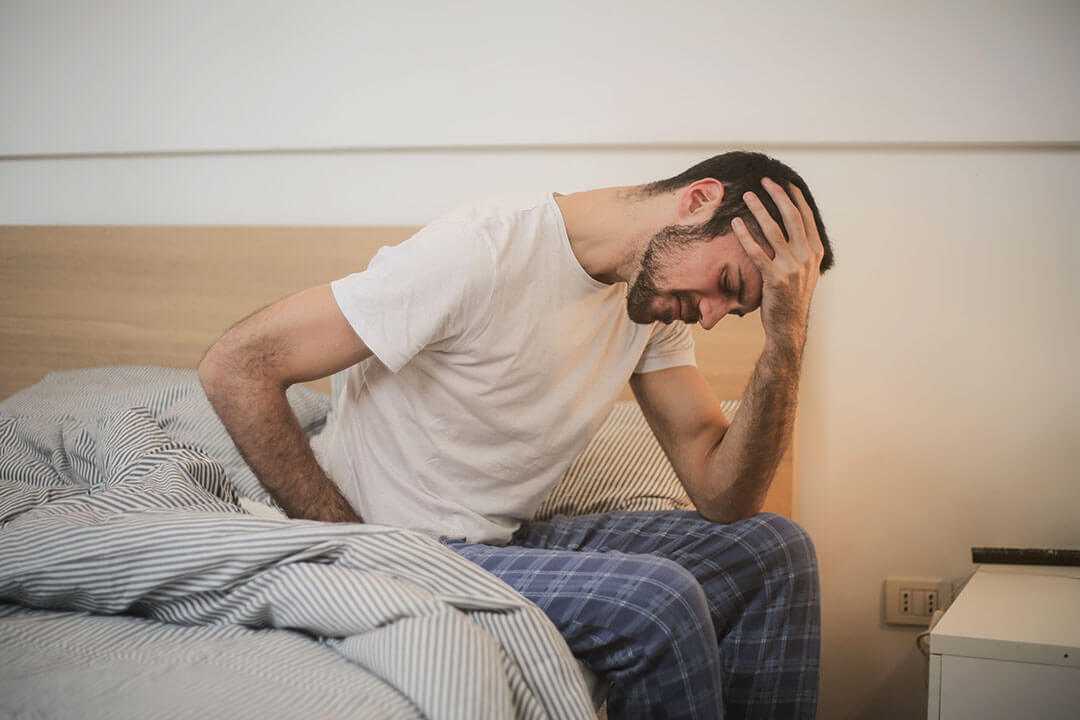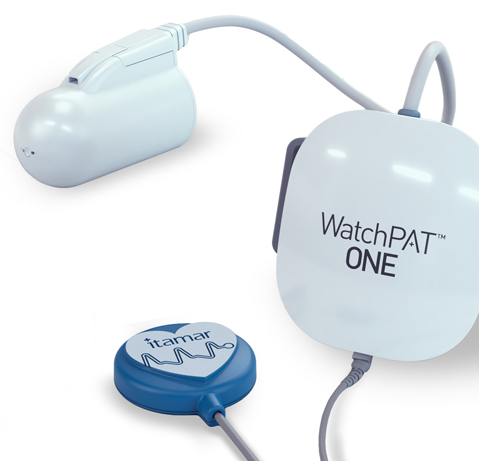
Do You Have Sleep Apnea? A Home Sleep Apnea Test Can Help
When to Use a Home Sleep Apnea Test
Do you often wake up in the morning with a dry mouth, headache, and a feeling that you barely slept?
Does your partner or roommate complain that you snore loudly every night?
Are you overweight, and struggling with medical conditions like pre-diabetes or type 2 diabetes, high blood pressure, GERD (acid reflux), depression or anxiety, among other health conditions?
If you said yes to any of the questions above, you may have a medical condition called sleep apnea. For many, a home sleep apnea test can help provide a much needed diagnosis and treatment plan from your doctor. It can also help you discover just how severe your sleep apnea is and what you can do to treat it.
What is Sleep Apnea?
Sleep apnea is a sleep disorder that closes off or partially blocks your airways at night repeatedly while you sleep. This alone can dramatically disrupt your sleep. Other signs of sleep apnea include:
During sleep:
- Snoring (at any level; snoring is the most visible sign of a blocked airway)
- Gasping for air
- Waking abruptly
- Sleeping on your side
Upon waking:
- Irritability
- Fatigue
- Anxiety
Sleep apnea is a serious medical condition, and although there are several different types of sleep apnea, each with respective causes and complications, the most common is obstructive sleep apnea.
Can a Home Sleep Apnea Test (HSAT) Diagnose Obstructive Sleep Apnea?
This is a common question. The answer is yes and no.
The purpose of a home sleep apnea test (HSAT) is to quickly identify the cases of severe sleep apnea first and confirm whether a patient has it. When there are strong telltale signs that a patient has sleep apnea and a confirmation is needed, a home sleep apnea test is a quick and cost-efficient diagnostic tool. More sophisticated HSATs are better able to confirm sleep apnea in patients who have mild to moderate obstructive sleep apnea.
An important distinction between a home sleep apnea test and a sleep study is that home tests are never a study. Calling it a study, rather than a sleep apnea test, contributes to the confusion and belief that sleep apnea can be conclusively ruled out by taking a home sleep apnea test. Home tests can’t rule out sleep apnea. It can only offer a confirmation diagnosis or provide a diagnosis of “inconclusive” when the test registers 5 or fewer incidents an hour.
An overnight sleep study is performed in a sleep lab and measures heart rate, blood oxygen levels, and brain waves.
Are All Home Sleep Apnea Test (HSAT) Devices the Same?
There are several home sleep apnea test devices used today. Some of these devices are better at diagnosing sleep apnea than others. At Sleep Centers of Middle Tennessee, we choose to use WatchPAT devices for most of our home sleep apnea testing.
WatchPAT uses a Peripheral Arterial Signal to measure the brain’s reaction to an obstructed airway, rather than measuring the obstruction itself. This allows for more accurate and reliable home testing and results in fewer inconclusive tests. More reliable testing can potentially reduce costs by reducing the need for a follow up test or in-lab study, in addition to reducing the time it takes to start treatment when needed.
Many traditional HSAT respiratory effort devices can confirm sleep apnea, but they can’t conclusively rule out sleep apnea. In fact, these HSAT (home sleep apnea tests) under-represent hypopneas and apneas and therefore miss most mild to moderate sleep apnea because the results are inconclusive.
In fact, up to 40% of home sleep tests can be inconclusive in some geographical areas (depending on the prevalence of sleep apnea) when using these types of home tests.1 Once an inconclusive test comes back, an in-lab study must be scheduled to confirm whether the patient has sleep apnea and to determine the level of severity.
Unfortunately, this causes confusion about the use and purpose of home sleep apnea tests. There is a lot of misunderstanding surrounding what home sleep apnea tests should be used and when they should be used. This has delayed treatment for many.
In some cases, where a more traditional version of a HSAT was used, people with sleep apnea failed to get treated. This is because events were under-represented during the test. This resulted in an inaccurate belief that they didn’t have obstructive sleep apnea.
Do You Have These Common Risk Factors Of Sleep Apnea?
Take this quick quiz to see if you have a low, medium or high risk sleep apnea profile. Easy, Fast, Secure.
Can Anyone Use a Home Sleep Apnea Test to Diagnose Sleep Apnea?
Not everyone is a candidate for a home sleep apnea test even, when an evaluation indicates they have sleep apnea. In certain instances, other risk factors may preclude the patient from taking a home sleep apnea test. It’s best to speak with a sleep specialist to determine if you’re a candidate for an in home sleep apnea test.
If Home Sleep Apnea Tests Can’t Determine if Someone Doesn’t Have Sleep Apnea, What Do They Do?
Home tests can’t determine if someone doesn’t have sleep apnea, but as we mentioned earlier, they are a quick and cost-efficient way to confirm sleep apnea.
There are two major reasons home sleep apnea tests are not ideal for testing someone who appears to have mild or moderate sleep apnea:
- They can’t produce a negative finding for sleep apnea. The results are either positive or inconclusive
- They greatly underestimate the number of apneas that occur while sleeping; so mild and moderate sleep apnea often falls within the “inconclusive” readings and an in-lab must still be scheduled
A traditional respiratory effort home sleep apnea test monitors your breathing while you sleep—it does not monitor how long you slept during the night. These sleep tests will often miss or under-represent mild and moderate sleep apnea cases because they can’t actually determine how long someone is asleep. There are no brain waves recorded.
If you have insomnia or are uncomfortable wearing the device and it takes longer to fall asleep or stay asleep, there’s no true way of knowing actual “sleep time”.
Sleep time is considered the “running time” of the test. However, if you’re not asleep during that time the actual number of apneas will appear to be less than they’d otherwise be if the actual sleeping time aligned with the recording time.
More advanced home testing devices such as the WatchPAT are able to detect when a person is asleep, which means it’s less likely to underestimate the number of apneas. The WatchPAT is able to do this because it uses peripheral arterial signals, rather than respiratory effort, which makes it a better choice for confirming mild or moderate sleep apnea.
An in-lab study is also able to determine the patient’s sleep time accurately and calculate the number of apneas or hypopneas because it allows for an EKG, which reads brain waves.
Is a Home Sleep Apnea Test Right for Me?
For the right candidate, a home sleep apnea test (HSAT) is an effective tool. So who is the right candidate for a sleep test?
A HSAT is recommended during an evaluation if it’s determined you have obstructive sleep apnea with a pre-test probability of 85% or higher and no other possible complications exist. Often, insurance providers will require a home sleep apnea test before they will authorize a sleep study.
Certain risk factors must be evaluated first, however, that may preclude you from taking a home test. For instance, if you have lung, heart or neurological diseases, then an in-clinic test is recommended. If you have a BMI over 40, an in-clinic test is recommended due to possible hyperventilation complications. If you use a pacemaker, are in renal failure, or are on alpha blockers, an in-lab may be indicated.
The key is to allow a qualified practitioner to identify the signs and determine whether an in-lab study is needed or if you qualify for a home test.
Some insurance companies require a home sleep apnea test prior to authorizing an in-lab test. This helps them avoid paying hospital fees that are around 3-5 times more expensive than an independent sleep center. In those cases, a sleep test will take place instead. However, if the results are inconclusive (because a sleep study can never be negative and rule out sleep apnea on its own), an in-lab test will be performed.2
What to Expect if a Home Sleep Apnea Test is Scheduled
Here’s how it works:
The home sleep apnea testing device will be shipped directly to your home anywhere in the state of Tennessee. For local patients, if preferred, we can arrange for the device to be picked up (curbside or in office) at one of our three sleep centers in Murfreesboro, Franklin or Clarksville. A medical professional will give you detailed instructions on the operation of your specific sleep apnea testing device.
Leading up to your test, try to stick to your normal bedtime routine. However, you should avoid consuming caffeine or taking a nap in the afternoon on the day of your home sleep test.
At bedtime, put the device on before going to bed. It’s recommended that you sleep on your back for the purpose of the home sleep study.
For some home sleep apnea tests, a nasal cannula monitors your breathing patterns, while a small clip on your finger measures oxygen levels. Other sensors are placed on your abdomen and chest to measure their rise and fall as you breathe.
The WatchPAT only requires you to insert a finger into the device. No nasal cannula or sensors on your chest or abdomen are needed. Lie down, get comfortable, and drift into dreamland.
Home sleep apnea tests are minimally invasive, take place in the safety and comfort of your bedroom, and are easy to hook up and get situated.
That’s it! Come morning, you’ll remove the device and either return it by mail (return postage included) or by dropping the device off at one of our three convenient locations. If you use a WatchPAT One device, you simply need to send us your sleep data via your smartphone and then throw the single-use disposable device away.
What Happens After My Home Sleep Apnea Test?
After you return your device, your results are reviewed by board-certified sleep specialists. Within 1-2 days, we’ll contact you to discuss your results and determine the appropriate next steps for you.
If the results of the test are inconclusive, the specialists at Sleep Centers of Middle Tennessee will contact you directly to discuss the next steps.
If the results indicate you have moderate or severe sleep apnea, an appointment will be scheduled to discuss the next steps. Possible treatment options such as oral appliances or continuous positive airway pressure (CPAP) will also be discussed.
Most people go from testing to treatment in around seven days, sometimes less.
Take the First Step
It can be frightening to think you might have sleep apnea—but finding out your diagnosis doesn’t have to be. At Sleep Centers of Middle Tennessee, our friendly and knowledgeable Advanced Practice Providers can talk you through the home sleep apnea test process and put your mind at ease. Don’t hesitate to take control of your sleep health.

